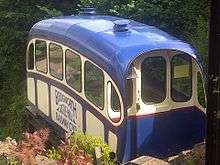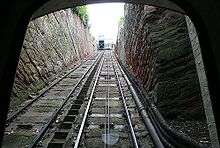Bridgnorth Cliff Railway
Coordinates: 52°32′02″N 2°25′01″W / 52.534°N 2.417°W


The Bridgnorth Cliff Railway, also known as the Bridgnorth Funicular Railway or Castle Hill Railway, is a funicular railway in the town of Bridgnorth in the English county of Shropshire. The line links the Low Town of Bridgnorth, adjacent to the River Severn, with the High Town, adjacent to the ruins of Bridgnorth Castle.
The line is one of four funicular railways in the UK built to the same basic design (the others were the Clifton Rocks Railway in Bristol; the Lynton and Lynmouth Cliff Railway in Devon; and the Constitution Hill Railway in Aberystwyth, Wales). It is one of the steepest railways in the country, and at least one source (the information panel outside the top station) claims it is both the steepest and shortest.
History
Following a public meeting in 1890 to discuss an alternative method of communication between the two parts of Bridgnorth to the 200 steps between High Town and Low Town, a proposal to build a Patent Cliff Railway was put to the town council. Engineered by George Croydon Marks, plans were accepted for funicular railway on the current route. The Bridgnorth Castle Hill Railway Company Ltd was registered in 1891, and construction started on 2 November 1891.[1] The company, which still operates the railway today, was founded by Sir George Croydon Marks (later Lord Marks of Woolwich),[2] who became its first managing director from 1891 until 1901. His brother, Edward Marks, became its second managing director from 1901 until 1924. George also coined the term 'Intellectual Property' and was the founder of the patent attorneys Marks & Clerk, who continue to trade.[3] The railway was opened on 7 July 1892 by Mayor John Anderson,[4] with a public holiday being proclaimed to celebrate the occasion.[5]
Most of the original funding came from George Croydon Marks' business partner, Sir George Newnes, MP, the wealthy publisher, who purchased eighty-five per cent of the share capital in Bridgnorth Cliff Railway and who became its first chairman. Newnes was already chairman of Lynton & Lynmouth Cliff Railway and went on to collaborate with Marks on other funicular projects. Newnes, who had previously founded 'Tit-bits' and the 'Strand Magazine', went on to found 'Country Life'.[6]
Originally the railway was powered by a simple system using water and gravity. Water was pumped into a 2,000-imperial-gallon (9,100 l; 2,400 US gal) tank beneath the top car until its weight, a maximum of 11.5 long tons (11.7 tonnes), overcame that of the lower car. When the car reached the bottom station the tank was emptied and pumped up to a 30,000-imperial-gallon (140,000 l; 36,000 US gal) tank on the top of the upper station.[5]
Between 1943 and 1944 the system was rebuilt to use electricity, with an official re-opening on 9 May 1944 by Mayor T.C. Pembro – who had taken office only 2 hours previously. In 1955 the original heavy wooden cars were replaced by the 'up-to-date' stronger and lighter (5.4 long tons or 5.5 tonnes) aluminium monocoque ones still in use today. Each car can carry up to 18 passengers.[7][8]
The rails were replaced in about 1972 with the bullhead design formerly used on mainline railways.[8]
Current situation
A vital part of the town's infrastructure the railway operates 362 days a year (it is closed on Christmas Day, Boxing Day and New Year's Day). Each journey takes about 1 and a quarter minutes, and on an average day approximately 200 trips are made. As of July 2015 return tickets cost £1.20 with discounts available for groups of 15 or more. Single tickets are not available.
The line has the following technical parameters:[8][9]
- Length: 201 feet (61 m)
- Height: 111 feet (34 m)
- Maximum Steepness: 64%
- Cars: 2
- Capacity: 18 passengers per car
- Configuration: Double track
- Track gauge: 3 ft 6 in (1,067 mm)
- Traction: Electricity
- Operation: Manually driven from upper station
The railway is owned and operated by a private company, The Bridgnorth Castle Hill Railway Company Limited, which was incorporated on 5 October 1891.[10] The current owners, who acquired the company and cliff railway in 2011, are direct descendants of George Croydon Marks' third cousin, all being descended from one Nicholas Jonas (later Jones) of Tawstock near Barnstable, north Devon. Other descendants of Jonas were the brothers Tom and Bob Jones, who founded Lynton & Lynmouth Cliff Railway, which was also engineered by the Marks brothers.
See also
References
- ↑ Bridgnorth and Its Castle Hill Railway (1 ed.). The Bridgnorth Castle Hill Railway Co Ltd. 1892.
- ↑ Lane, Michael (1986). Baron Marks of Woolwich: International Entrepreneur, Egineer, Patent Agent and Politician. London: Quilter Press. ISBN 0907621775.
- ↑ Lane, Michael (1986). Baron Marks of Woolwich: International Entrepreneur, Engineer, Patent Agent and Politician (1 ed.). Quilter Press. p. 28. ISBN 0907621775.
- ↑ "Wellington Journal". 9 July 1892.
- 1 2 "History of the Railway". Bridgnorth Castle Hill Railway Company Ltd. Retrieved 9 March 2007.
- ↑ Friederichs, Hulda (1911). The Life of Sir George Newnes Bart. London: Hodder & Stoughton.
- ↑ "History". Bridgnorth Castle Hill Railway Company Ltd. Retrieved 9 March 2007.
- 1 2 3 "Technical". Bridgnorth Castle Hill Railway Company Ltd. Retrieved 8 March 2007.
- ↑ "Bridgnorth Castle Hill Lift". Funiculars.net. Retrieved 8 March 2007.
- ↑ "WebCHeck". Retrieved 16 January 2012.
External links
| Wikimedia Commons has media related to Bridgnorth Cliff Railway. |